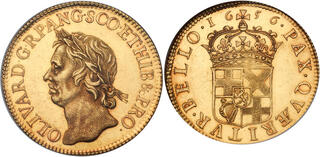| Ira & Larry Goldberg Coins & Collectibles > Auction 137 | Auction date: 29 January 2024 |
| Lot number: 1124 Price realized: 75,000 USD (Approx. 69,465 EUR) Note: Prices do not include buyer's fees. | Show similar lots on CoinArchives Find similar lots in upcoming auctions on |
| Lot description: Great Britain. Pattern Broad, 1656. S.3225; Fr-273; KM-PN25; WR-39. Reeded edge. By Thomas Simon. Oliver Cromwell. Laureate bust left. Reverse; Crowned arms. The so-called gold Broad, valued in 1656 at 20 shillings, was in effect the very first Guinea, which was invented in the following decade and also valued at 20 shillings. Reflective surfaces with sparkling luster, this specimen has great eye-appeal. Very Rare. Pop 7; 3 in 63; 1 in 64. NGC graded MS-62. Estimated Value $20,000 - UP "Laureate" bust of the Protector facing left surrounded by his titles in Latin (mostly abbreviations). On the reverse side we see Cromwell's family crest substituting for the traditional royal shield, crowned, dated 1656 at top along rim followed by the Latin legend reading PAX QVAERITVR BELLO ("Peace is Sought by War"), Cromwell's favorite slogan which is seen only on this coin and on the thicker 50-shillings gold coin of the same date. Reeded edge (also called "grained edge"). The only English coin known by this denomination, this beautifully engraved, modern-style coin was of the same "face value" as certain large gold coins of previous monarchs, coins that were made by the hammered process-which this coin made obsolete since it was so much finer looking. That value was its equivalent in 20 silver shillings. A few short years in the future a new denomination, called the guinea, would replace it and become dominant in English economics for a century and a half. The broad was one of the first English coins made by machinery (known as "milled") rather than by the ancient method of striking money using hand-held hammers. The new presses were imported from France by Pierre Blondeau. The dies for the coins were engraved by Thomas Simon. Cromwell's portrait was made modern looking, as well as lifelike, using the "stippled" style of engraving that became a feature of Simon's skills. Never before had English money portrayed the ruler looking as he or she did in life-coins that were perfectly round in shape, consistently sharp in details and gleaming with luster. This coin changed the nature of money in Great Britain. Ex Goldberg Sale 34, Feb 5, 2006, lot 2238. |  |


